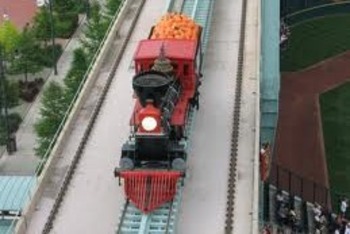
I'm all aboard the Houston Astros'Â movement towards removing Tal's Hill and the train from Minute Maid Park.
Zachary Levine reports for the Houston Chronicle that Astros owner Jim Crane said the club will weigh removing both quirky features before next year when it moves to the American League and re-brands.
“Those are two things people question me about all the time and those are logical,†Crane said. â€We’re going to do our marketing research. We’re going to study it.â€
Forget market research. Study this.
Here are six reasons both Tal's Hill and the train must go.
Tal's Hill Doesn't Serve A Purpose
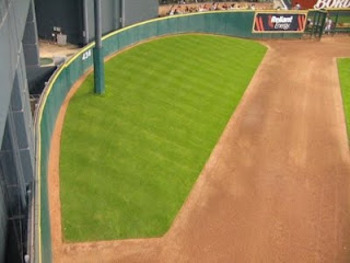
Tal's Hill is rather empty these days.
Embankments in old stadiums were usually built to provide better views for overflow crowds standing on the field.
That's not necessary or allowed in Houston.
Tal's Hill, a tribute to Cincinnati's Crosley Field, is named after team president Tal Smith. He allegedly added the feature to stadium blueprints on a whim while not expecting it to actually be built.
Before warning tracks, raised areas were not uncommon in outfields.
Crosley Field featured a natural outfield embankment unlike its man-made tribute in Houston. Fenway Park once featured Duffy's Cliff in front of the Green Monster. The Albuquerque Isotopes (Triple-A affiliate of the Los Angeles Dodgers) play in Isotopes Park, which still has a man-made hill in center field as well.
A raised outfield area still exists at Finch Field (formerly used in professional baseball during the 1960's) in Thomasville, NC. Nashville's Sulpher Dell and its large embankment in right field hosted professional baseball into the 1960's, too.
Back then, raised outfields actually served a purpose. Tal's Hill may be a nice tribute to the past, but there's nothing natural or useful about it now.
Players Hate Tal's Hill
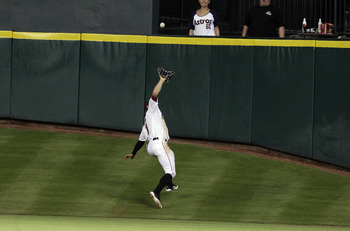
Jordan Schafer made a nice catch on Tal's Hill, but he still wants to see it removed.
Bob Levey/Getty Images
If Jim Crane is really going to do market research on whether or not to remove Tal's Hill, he should start by talking to his own players.
They are the ones that have to play on it. Their opinion matters most.
Current Astros center fielder Jordan Schafer wants to see the hill removed, even after making a spectacular catch on the hill against the Cincinnati Reds.
"I'm not too fond of that hill out there," Schafer said in a story by MLB.com's Brian McTaggart. "I hope they get rid of it next year. I feel like I could fall on my face."
"I just think it's a matter of time before someone gets hurt. For me, it would be a shame to see somebody tear an ACL and be out for the year because they're running up a hill. It's something unique about our park, but I'd rather be healthy all year instead of run up a hill and tear an ACL."
Schafer isn't alone. Former Astros center fielder Craig Biggio did fall on his face while trying to make a catch on Tal's Hill. He, too, was vocal about his distaste for the feature. Any visiting outfielder typically shares those same sentiments as well.
Who cares if the fans like Tal's Hill or not (and Crane will quickly find that many Astros fans do not)? It may be fun to watch highlight catches by players running up the incline, but Crane should first seek to appease his own employeesâ€"the ones actually affected by the hazard.
Tal's Hill Is a Hazard

Tal's Hill is all fun and games until somebody gets hurt.
There are no known injuries caused by Tal's Hill over its 13-year history, but that doesn't mean one isn't coming.
Today's players don't have much if any experience with the once common but now rare outfield embankments. Even if they did, changing inclines while running full speed and looking up to track a ball is still dangerous.
"They need to take that thing out because it's real bad," Timo Perez said, according to a story from the Houston Chronicle archives. "I thought I was going to get Berkman's line drive. When I went to put my glove out, I didn't have any more balance. My head hit the ground before I knew it. I hope nobody breaks their neck out there because it would be really sad."
That same story claims Craig Biggio suffered whiplash from falling face first on the hill.
Spectacular catches are fun to watch, but that is not worth the risk of serious injury.
Tal's Hill Changes the Game

Bob Levey/Getty Images
Because hills are no longer common features in today's stadiums, the few that do remain bring chaos into competition.
The playing field is literally uneven.
Players should not be faced with stadium features they can't practice on. Different outfield dimensions are fine, but everything inside those dimensions in play for competition needs to be familiar to the athletes.
Even the Astros players can't get over Tal's Hill.
"You can't practice for it," Craig Biggio said, according to a story from the Houston Chronicle archives. "You just can't because you don't practice full speed. When you get in a game, you go 100 percent. At that angle it's hard to run full speed and prepare for the severity of the incline."
ESPN's Eric Neel endorses Tal's Hill for all the wrong reasons.
"I'm down with it, because it adds a sort of beer-league degree of difficulty, making superstar outfielders look just as goofy as the rest of us every once in a while."
Baseball is not a game show. It is a professional sport. It is the player's job to practice and master that profession. Watching an outfielder attempt something he is not trained to do may be entertaining to some, but it's terrifying to anyone that actually cares about the player or the game's outcome.
Save unexpected hazards for shows like Wipeout, where the contestants are supposed to look foolish. If you are like Neel and want to see MLB players fumbling around the outfield, just go watch Mark Reynolds or Alfonso Soriano. The PGA Tour's U.S. Open is another annual humbling of pro athletes you may enjoy.
Every professional sport requires standardized playing surfaces. Baseball needs to follow suit.
A Flagpole Is on the Field
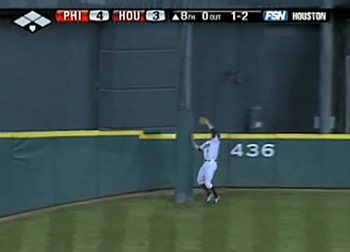
I'm all for patriotism, but a flagpole never belongs on a competitive field.
Salute the flag before the game, not during it.
At least Tal's Hill is just a playing surface issue. A flagpole in play is clearly an obstruction. There is no need for it to be there at all. It only hurts the game and in no way helps it.
This should have been obvious before construction, but Richie Sexson's double that left a mark on the pole proved it for all to see on July 1, 2003. The hit clearly should have been a homer, but Sexson was eventually stranded on third base. It came in the fourth inning as the Brewers went on to lose by one run in 10 innings.
That a pole is even allowed in play at all is completely ridiculous.
It was inspired by Tiger Stadium, which once had a similar feature. Yankee Stadium not only featured a flagpole in play, but monuments as well. Pittsburgh's old Forbes Field placed a batting cage in play in deep center field.
Those obstructions have since been removed. The one in Houston should be, too.
The Train Is Also out of Place
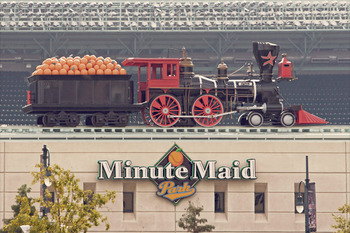
The train that runs high above left field in celebration of Astros home runs isn't nearly as bad as Tal's Hill or the flagpole.
It doesn't at all interfere with the game, although it may tempt players to take shots at it in hopes of demolition.
Practical arguments like player safety and game obstruction don't apply here. But really, how does a train pulling a cart of oranges celebrate productivity on the baseball field?
BaseballPilgimages.com tries to make sense of this.
"The railroad theme for the ballpark sprung out of the Astros’ decision to utilize Union Station, an authentic 1911 railroad station where everything is original except the floor. Team officials estimate that approximately 60 percent of fans enter Minute Maid Park via Union Station's 45-foot-high lobby, which dates to the time period when railroads constituted the city's largest industry."
So that explains the train. The over-sized oranges that look more like pumpkins clearly tie into stadium sponsor Minute Maid.
Let's call it all a good try. I do appreciate consideration for a town's history. Unfortunately, this is not like gift giving. It's not the thought that counts when the execution is so off.
The train itself looks completely outdated, even for a station dating back to 1911. I'm thinking at least 19th century, perhaps even pre-Civil War. Somehow, I doubt that many of today's fans appreciate the subtle historical significance of the obviously old-fashioned vehicle. That those fans cheer a team whose name alludes to something much more futuristic doesn't help.
Regardless of the era, it's not like Houston was unique in featuring a train station downtown. I don't see this as a distinguishing element of the city worthy of recognizing with stadium design.
When I think Houston, trains don't exactly come to mind. Space exploration seems like a much better fit, especially considering the team name. But this is not a call to replace the train with a spaceship, just a call for the train to leave this station.
Tal's Hill and the flagpole better be all aboard.
Begin Slideshow
Keep ReadingProps (0)
![]()
What is the duplicate article?
Why is this article offensive?
Where is this article plagiarized from?
Why is this article poorly edited?
Flag This Article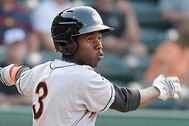


No comments:
Post a Comment